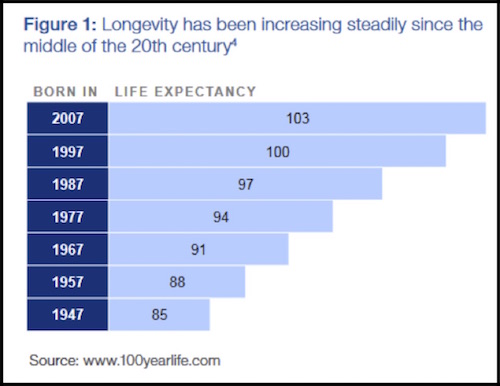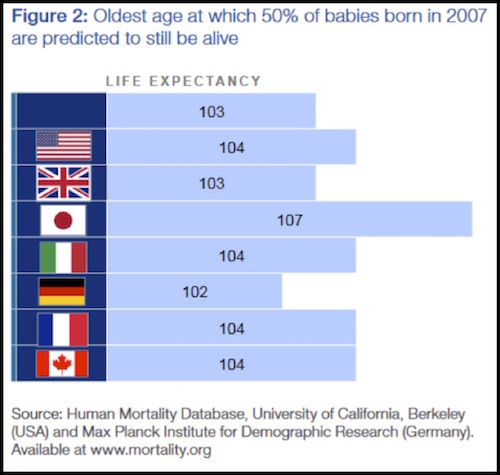I’m also pleased to announce that next year we’re taking SIC back to our old home at San Diego’s Manchester Hyatt. The dates are March 6–9, 2018. That’s just a little more than nine months away, so now is the time to start planning your trip. We’ll let you know when early bird registration opens in the fall.
Now, on to this week’s main course.
Centenarians Everywhere
One of my team members pointed me to a World Economic Forum white paper called “We’ll Live to 100 – How Can We Afford It?” Regular readers know I’ve been saying we’ll live that long – and asking how we’ll pay for it – for several years now. It is good to see Davos Man finally catching up with me.
The WEF paper has some interesting data that I haven’t seen elsewhere. To begin, it breaks down life expectancy by birth year, showing a different picture than we see from simple averages. Here are the global numbers.

As far as I can tell, these estimates don’t consider the kind of major life-extending breakthroughs that Patrick Cox writes about for us and that he and I both expect to be realized in the next few years. Rather, the methodology of the WEF paper seems to depend on extending current trends. So I believe the numbers above are conservative.
Note also, these are median life expectancies, not simple averages. Half the people in each group will live longer than the median. Most of today’s young children will live to see the 2100s. Some (many?) of the younger Millennials will see their lives span three different centuries. That’s astonishing.
Here’s another table showing the differences among major countries for those born in the year 2007.

Again, this is astounding if correct. A Japanese child born in 2007, who is 10 years old today, has a 50% chance of living to 107. That will be the year 2114. Those in other developed countries are not far behind.
Better yet, the coming medical technologies will let us live to those ages or more without the decades of physical and mental decline that are now common. We’re not just increasing lifespans; we’re increasing “health spans,” too.
The good news is that many of those antiaging breakthroughs are going to be coming to a pharmacy near you in the near future – as in five to ten years. It is likely that you will live much longer and healthier than you are currently planning to. Most of us will be happy with that outcome. The bad news is that you will have to make your money last those extra years.








